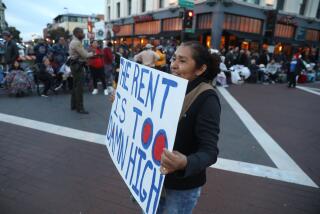0.5% of Families Found to Hold 35% of Wealth
- Share via
WASHINGTON — More than a third of the nation’s net wealth is held by 0.5% of American households, a concentration of economic clout that has snowballed to levels not seen since the Great Depression, Democrats on Congress’ Joint Economic Committee concluded in a study released Friday.
Their report, using 1983 figures compiled for the Federal Reserve Board, stated that the 420,000 richest U.S. families controlled $3.7 trillion of the nation’s $10.6 trillion in assets after debts. That is 35.1% of total wealth.
Similar Study in 1962
An earlier Fed study using 1962 data concluded that the same 0.5% of the population then controlled 25.4% of the national wealth. By comparison, the report stated, the share of assets held by the poorest 90% of American households dropped during those 21 years from 34.9% to 28%.
The committee Democrats’ report provided the first public comparison of the two studies, both of which were conducted for the Fed by the University of Michigan’s prestigious Survey Research Center. The 1983 study was based largely on projections from a survey of about 4,000 Americans. The sample included 432 members of the country’s wealthiest families.
The chairman of the joint committee, Rep. David R. Obey (D-Wis.), said the figures are “proof that the rich get richer,” adding: “If wealth is power, then most Americans have less power today than in the early 1960s.”
But a Republican on the panel, Rep. Daniel E. Lungren of Long Beach, called the conclusions far-fetched, saying the 1962 and 1983 studies omitted the value of pensions and Social Security benefits, “two of the greatest actual accumulations of wealth in the middle class.”
In the report, the 1983 data is divided into four classes of households:
--420,000 “super rich” families, with more than a third of the wealth and composing 0.5% of families. None of these families were worth less than $2.5 million; their average wealth, after debts, was $8.85 million.
--420,000 “very rich,” with 6.7% of all net assets and an average wealth of $1.7 million.
--7.6 million “rich,” with net wealth ranging from $206,000 to $1.4 million and an average net worth of $419,616. The rich, 9% of all households, owned 29.9% of the wealth.
--”Everyone else,” 75.5 million households that made up the remaining 90% of the population. Their net worth ranged no higher than $206,000 and averaged $39,584.
The wealthy excelled in another crucial statistical measure as well: The net worth of the super rich rose during the 21-year period by 147%, adjusted for inflation. The very rich managed only a 64% increase and the rich, a 66% gain. Everyone else posted a more modest 45% increase.
Mismeasurements Cited
The survey does slightly underestimate the worth of the bottom 90% of households, the committee report admitted, by omitting ownership of autos, stereos, appliances and other big-ticket items, while deducting from total wealth any unpaid loan balances on those items. Some other yardsticks of bottom-tier wealth also are mismeasured, but the errors probably are small, the report stated.
Federal Reserve economist Art Kennikell said the two wealth surveys are probably the broadest and most accurate measures of assets ever taken, adding that the 1983 survey was drafted along the same lines as the 1962 report. Although both reports are likely to contain some inaccurate measurements, he said, the results should be comparable and any trends should be generally accurate.
Henry Aaron, an expert on income at the Brookings Institution, said the Fed data appears to be the most comprehensive of its kind to date. However, he cautioned, accurate estimates of income and wealth distribution are unusually difficult to make because of privacy safeguards and other data-collection problems.
According to the report, what the various classes of households owned varied almost as much as how much they owned. The super rich and very rich--the top 1%--together controlled two-thirds of all unincorporated business assets and 60% of all corporate stock owned by individuals.
Assets in Real Estate
Nearly half the net assets of the bottom 90% were tied up in real estate, most of it in homes. Real estate was among the fastest-appreciating assets, more than doubling in value from 1962 to 1983.
The super rich, meanwhile, had less than a fifth of their money in real estate in 1983. But the worth of their property holdings grew sevenfold during the 21 years between surveys.
Half of the wealth of the super rich was sunk into business assets, which rose from $206 billion in 1962 to $1.9 trillion in 1983. By way of contrast, the business holdings of “everyone else” virtually stagnated, rising $8 billion to $214 billion.
Obey blamed the Reagan Administration for the “disturbing” trend, saying that early White House tax policies “did nothing to narrow the gap.”
Lungren, however, said the wealth study “flies in the face” of a recent Internal Revenue Service analysis of tax figures, which stated that the concentration of wealth may have declined since 1976 instead of rising. The IRS report relied on income figures instead of measures of accumulated wealth.
More to Read
Get the L.A. Times Politics newsletter
Deeply reported insights into legislation, politics and policy from Sacramento, Washington and beyond. In your inbox twice per week.
You may occasionally receive promotional content from the Los Angeles Times.










